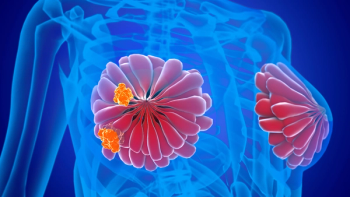
Disitamab Vedotin/Toripalimab Boost Survival in HER2+ UC
Disitamab vedotin/toripalimab improved PFS and OS vs chemotherapy in HER2-expressing advanced urothelial carcinoma, per phase 3 RC48-C016 data.
Frontline treatment with disitamab vedotin plus toripalimab-tpzi (Loqtorzi) significantly prolonged progression-free survival (PFS) and overall survival (OS) vs standard chemotherapy in patients with HER2-expressing locally advanced or metastatic urothelial carcinoma, according to findings from the phase 3 RC48-C016 trial (NCT05302284) presented at the 2025 European Society for Medical Oncology Congress and published simultaneously in the New England Journal of Medicine.1,2
With a median survival follow-up of 18.2 months and a data cutoff date of March 31, 2025, the median PFS per blinded independent review committee (BIRC) was 13.1 months (95% CI, 11.1-16.7) with the disitamab vedotin treatment compared with 6.5 months (95% CI, 5.7-7.4) with chemotherapy, representing a 64% reduction in the risk of progression or death (HR, 0.36; 95% CI, 0.28-0.46; P <.0001). The 12- and 18-month PFS rates with disitamab vedotin were 54.5% and 38.4%, respectively, vs 16.2% and 7.5% with chemotherapy.
The median OS was 31.5 months (95% CI, 21.7-not evaluable) in the disitamab vedotin arm compared with 16.9 months (95% CI, 14.6-21.7) in the chemotherapy arm, correlating with a 46% reduction in the risk of death (HR, 0.54; 95% CI, 0.41-0.73; P <.0001). The 12-, 18-, and 24-month OS rates in the disitamab vedotin arm were 79.5%, 64.6%, and 52.8%, respectively; in the chemotherapy arm, these rates were 62.5%, 48.1%, and 39.4%.
The PFS and OS benefits were consistent across all prespecified subgroups.
In the disitamab vedotin arm, the overall response rate (ORR) per BIRC was 76.1% (95% CI, 70.3%-81.3%), with complete responses (CRs) in 4.5% and partial responses (PRs) in 71.6% of patients; in the chemotherapy arm, the ORR was 50.2% (95% CI, 43.7%-56.7%), with CRs in 1.2% and PRs in 49.0%. The investigator-assessed ORR with disitamab vedotin was 71.6% (95% CI, 65.5%-77.2%), with CRs in 4.1% and PRs in 67.5% of patients compared with a 49.8% ORR (95% CI, 43.3%-56.3%) with chemotherapy, comprising CRs in 3.3% and PRs in 46.5% of patients.
The median duration of response per BIRC was 14.6 months (95% CI, 11.3-18.7) with the disitamab vedotin combination compared with 5.6 months (95% CI, 5.3-5.8) with chemotherapy. In the disitamab vedotin arm, the 6-, 12-, and 18-month duration of response (DOR) rates were 78.9%, 58.5%, and 42.4%, respectively; in the chemotherapy arm, these rates were 37.2%, 19.0%, and 8.7%.
“The phase 3 RC48-C016 study demonstrated for the first time superiority of an anti-HER2 antibody-drug conjugate plus an anti–PD-1 inhibitor in a biomarker-selected patient population with [locally advanced and metastatic urothelial cancer],” lead study author Jun Guo, of the Key Laboratory of Carcinogenesis and Translational Research in the Department of Melanoma and Sarcoma at Peking University Cancer Hospital and Institute in Beijing, China, said in the presentation. “Disitamab vedotin plus toripalimab offers a valuable new treatment option and represents a new standard of care for the [first-line] treatment of patients with HER2-expressing [locally advanced or metastatic urothelial cancer].”
The open-label RC48-CO16 trial randomly assigned 484 patients 1:1 to receive either disitamab vedotin plus toripalimab (n = 243) or gemcitabine plus cisplatin/carboplatin (n = 241). Treatment consisted of 2.0 mg/kg of intravenous disitamab vedotin and 3.0 mg/kg of toripalimab every 2 weeks, or gemcitabine at 1000 mg/m2 on day 1 and day 8 and cisplatin at 70 mg/m2 on day 1 or carboplatin at area under the curve 4.5 on day 1 every 3 weeks. There was no maximum number of cycles set for the disitamab vedotin treatment, and the maximum number of chemotherapy cycles was 6.
Eligible patients in the trial had no prior systemic treatment for unresectable locally advanced or metastatic urothelial cancer and central lab-confirmed HER2 immunohistochemistry of 1+, 2+, or 3+; additionally, patients were eligible for cisplatin or carboplatin, had measurable disease per RECIST v1.1, and had an ECOG performance status of 0 or 1.
The primary end points were PFS per BIRC and OS. Secondary end points included PFS by investigators, ORR, DCR, DOR, safety, and quality of life.
Subsequent systemic anticancer treatment was received by 27.2% of patients on the disitamab vedotin arm and 64.7% on the chemotherapy arm; this comprised anti–HER2-containing therapy in 2.1% and 40.2%, respectively, PD-1/PD-L1 inhibitor therapy in 10.7% and 50.2%, and both in 0.8% and 31.1%.
Regarding safety, treatment-emergent adverse events (TEAEs) occurred in 100% of patients across both arms, and treatment-related AEs (TRAEs) occurred in 98.8% of patients on the disitamab vedotin arm and 100% of those on the chemotherapy arm. Grade 3 or higher TRAEs occurred in 55.1% and 86.9% of patients, respectively; grade 3, 4, and 5 TRAEs were observed in 44.0%, 9.9%, and 1.2% of those on the experimental arm vs 41.9%, 43.7%, and 1.4% of the chemotherapy arm. TRAEs led to treatment discontinuation in 12.3% vs 10.4%, respectively.
Any-grade and grade 3 or higher immune-related AEs occurred in 46.9% and 18.9% of the disitamab vedotin arm.
References
- Sheng X, Zeng G, Zhang C, et al. Disitamab vedotin (DV) plus toripalimab (T) versus chemotherapy (C) in first-line (1L) locally advanced or metastatic urothelial carcinoma (la/mUC) with HER2-expression. Presented at: European Society of Medical Oncology Congress; October 17-21, 2025; Berlin, Germany. Abstract LBA7.
- Sheng X, Zeng G, Zhang C, et al;
RC48-C016 Trial Investigators . Disitamab vedotin plus toripalimab in HER2-expressing advanced urothelial cancer. N Engl J Med. Published online October 19, 2025. doi:10.1056/NEJMoa2511648
Newsletter
Knowledge is power. Don’t miss the most recent breakthroughs in cancer care.



















































































